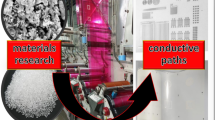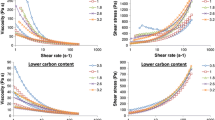Abstract
Printing of conductive inks is an attractive means of manufacturing of electronic components on flexible substrates including textiles. The textiles thus produced are often referred to as “e-textiles.” When high electrical conductivity is required, inks are preferably made from metal nanoparticles such as silver. However, such inks are expensive and generally not known to withstand severe washing and wearing to which textiles are normally subjected during the end use. In the present study, which forms a part of a larger study by the authors, waterborne dispersions of conductive grades of carbon black were converted into finished inks followed by washing and creasing tests to ascertain the durability of these inks. We found that not only were the inks stable after letdown with different binders, but they possessed high electrical conductivity despite the fact that the final pigment loading in all of the formulated inks was significantly less than the pigment loading that is generally found in commercial conductive inks. In addition, the electrical conductivity after washing and creasing tests of the formulated inks was found to be significantly greater than that of the tested commercial conductive inks. This shows that using large surface area, highly conductive grades of carbon black pigments in relatively small amounts in inks for textile printing is beneficial in achieving some of the critically required characteristics, particularly those pertaining to durability of the ink film.



Similar content being viewed by others
References
Van, LL, Hertleer, C, “Smart Clothing: A New Life.” Int. J. Cloth. Sci. Technol., 16 63–72 (2004)
Marculescu, D, “E-textiles: Toward Computational Clothing.” Pervasive Comput IEEE, 2 89–95 (2003)
Troster G, Kirstein T, Lukowicz P, “Wearable Computing: Packaging in Textiles and Clothes.” 14th European Microelectronics and Packaging Conference & Exhibition. Friedrichshafen, Germany: Wearble Computing Lab, ETH Zurich (2003)
Mattana, G, Cosseddu, P, Fraboni, B, et al., “Organic Electronics on Natural Cotton Fibres.” Org. Electron., 12 2033–2039 (2011). https://doi.org/10.1016/j.orgel.2011.09.001
Paradiso R, Rossi DD, “Advances in Textile Technologies for Unobtrusive Monitoring of Vital Parameters and Movements.” Engineering in Medicine and Biology Society, 2006 EMBS ‘06 28th Annual International Conference of the IEEE 30/08–03/09/2006, pp 392–395, 2006
Marculescu, D, Marculescu, R, Zamora, NH, et al., “Electronic Textiles: A Platform for Pervasive Computing.” Proc. IEEE, 91 1995–2018 (2003). https://doi.org/10.1109/jproc.2003.819612
Dhawan, A, Seyam, AM, Ghosh, TK, et al., “Woven Fabric-Based Electrical Circuits: Part I: Evaluating Interconnect Methods.” Text. Res. J., 74 913–919 (2004). https://doi.org/10.1177/004051750407401011
Locher, I, Troster, G, “Enabling Technologies for Electrical Circuits on a Woven Monofilament Hybrid Fabric.” Text. Res. J., 78 583–594 (2008). https://doi.org/10.1177/0040517507081314
Gimpel, S, Mohring, U, Muller, H, et al., “Textile-Based Electronic Substrate Technology.” J. Ind. Text., 33 179–189 (2004). https://doi.org/10.1177/1528083704039828
Post RE, Orth M, Cooper E, et al, “Electrically Active Textiles and Articles Made Therefrom.” US Patent 6,210,771, 2001
Bao, Z, Feng, Y, Dodabalapur, A, et al., “High-Performance Plastic Transistors Fabricated by Printing Techniques.” Chem. Mater., 9 1299–1301 (1997). https://doi.org/10.1021/cm9701163
Gray C, Wang J, Duthaler G, et al, “Screen Printed Organic Thin Film Transistors (OTFTs) on a Flexible Substrate.” Organic Field Effect Transistors, pp 89–94. SPIE, San Diego, CA, USA, 2001
Tymecki, L, Glab, S, Koncki, R, “Miniaturized, Planar Ion-Selective Electrodes Fabricated by Means of Thick-Film Technology.” Sensors, 6 390–396 (2006)
Michels, JJ, de Winter, S, Symonds, LHG, “Process Optimization of Gravure Printed Light-Emitting Polymer Layers by a Neural Network Approach.” Org. Electron., 10 1495–1504 (2009). https://doi.org/10.1016/j.orgel.2009.08.015
Ghosh, TK, Dhawan, A, Muth, JF, “Formation of Electrical Circuits in Textile Structures.” In: Matilla, H (ed.) Intelligent Textiles and Clothing. Woodhead Publishing, Cambridge (2006)
Merilampi, S, Laine-Ma, T, Ruuskanen, P, “The Characterization of Electrically Conductive Silver Ink Patterns on Flexible Substrates.” Microelectron. Reliab., 49 782–790 (2009). https://doi.org/10.1016/j.microrel.2009.04.004
Locher, I, Tröster, G, “Screen-Printed Textile Transmission Lines.” Text. Res. J., 77 837–842 (2007). https://doi.org/10.1177/0040517507080679
Kazani, I, Hertleer, C, De Mey, G, et al., “Electrical Conductive Textiles Obtained by Screen Printing.” Fibres Text. East. Eur., 20 57–63 (2012)
Inoue M, Tada Y, Muta H, et al, “Development of Highly Conductive Inks for Smart Textiles”. 14th International Conference on Electronic Materials and Packaging (EMAP) pp 1–4, 13–16 Dec. (2012)
Park SM, Cho KS and Chung KH, “Flexible Printed Conductive Fabric and Method of Fabricating the Same.” Patent WO 2008/060101, 2007
Karaguzel, B, Merritt, CR, Kang, T, et al., “Flexible, Durable Printed Electrical Circuits.” J. Text. Inst., 100 1–9 (2009)
Bidoki, SM, Lewis, DM, Clark, M, et al., “Ink-Jet Fabrication of Electronic Components.” J. Micromech. Microeng., 17 967–974 (2007). https://doi.org/10.1088/0960-1317/17/5/017
Jang BZ, Zhamu A, “Nano Graphene Platelet-Based Conductive Inks.” US Patent 20100000441 A1, USA, 2008
Hu, L, Pasta, M, La Mantia, F, et al., “Stretchable, Porous, and Conductive Energy Textiles.” Nano Lett., 10 708–714 (2010). https://doi.org/10.1021/nl903949m
Krucińska, I, Skrzetuska, E, Urbaniak-Domagała, W, “The Use of Carbon Nanotubes in Textile Printing.” J. Appl. Polym. Sci., 121 483–490 (2011). https://doi.org/10.1002/app.33598
Ma, R, Suh, D, Kim, J, et al., “A Drastic Reduction in Silver Concentration of Metallic Ink by the Use of Single-Walled Carbon Nanotubes Decorated with Silver Nanoparticles.” J. Mater. Chem., 21 7070–7073 (2011). https://doi.org/10.1039/C1JM10850F
Kaynak, A, Håkansson, E, “Generating Heat from Conducting Polypyrrole-Coated PET Fabrics.” Adv. Polym. Technol., 24 194–207 (2005). https://doi.org/10.1002/adv.20040
Gregory, RV, Kimbrell, WC, Kuhn, HH, “Electrically Conductive Non-Metallic Textile Coatings.” J. Ind. Text., 20 167–175 (1991). https://doi.org/10.1177/152808379102000304
Zhao, Y-P, Cai, Z-S, Fu, X-L, “Effect of Polymeric Additives on the Formation and Properties of Polyaniline Films on Polyester Fabrics.” J. Text. Inst., 103 724–732 (2011). https://doi.org/10.1080/00405000.2011.603203
Ali, M, Lin, L, Cartridge, D, “High Electrical Conductivity Waterborne Dispersions of Carbon Black Pigment.” Progress Org. Coat., 129 199–208 (2019). https://doi.org/10.1016/j.porgcoat.2018.12.010
Ali, M, Lin, L, “Optimisation and Analysis of Bead Milling Process for Preparation of Highly Viscous, Binder-Free Dispersions of Carbon Black Pigment.” Progress Org. Coat., 119 1–7 (2018). https://doi.org/10.1016/j.porgcoat.2018.02.007
Hobisch G, Tsang M, “New Waterborne Pigment Grinding Resin for High-Performance Coatings.” Paint and Coatings Industry Magazine, 2009
Baez, E, Quazi, N, Ivanov, I, et al., “Stability Study of Nanopigment Dispersions.” Adv. Powder Technol., 20 267–272 (2009). https://doi.org/10.1016/j.apt.2009.02.005
Ridaoui, H, Jada, A, Vidal, L, et al., “Effect of Cationic Surfactant and Block Copolymer On Carbon Black Particle Surface Charge and Size.” Colloids Surf. A Physicochem. Eng. Asp., 278 149–159 (2006). https://doi.org/10.1016/j.colsurfa.2005.12.013
Acknowledgments
The authors would like to acknowledge NED University of Engineering and Technology, Karachi, for providing the financial support to carry out this study.
Author information
Authors and Affiliations
Corresponding author
Additional information
Publisher's Note
Springer Nature remains neutral with regard to jurisdictional claims in published maps and institutional affiliations.
David Cartridge—retired from Lubrizol Corporation, Manchester, UK.
Rights and permissions
About this article
Cite this article
Ali, M., Lin, L. & Cartridge, D. High electrical conductivity waterborne inks for textile printing. J Coat Technol Res 16, 1337–1349 (2019). https://doi.org/10.1007/s11998-019-00214-5
Published:
Issue Date:
DOI: https://doi.org/10.1007/s11998-019-00214-5




